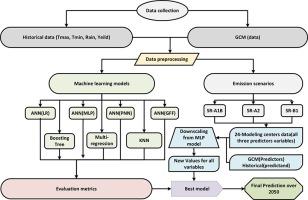Machine learning-based cotton yield forecasting under climate change for precision agriculture
IF 5.7
Q1 AGRICULTURAL ENGINEERING
引用次数: 0
Abstract
The escalating threat of climate change presents a significant challenge to modern agriculture, with serious consequences for global food security. The impact of changing climate variables on crop productivity, particularly for key agricultural commodities, raises concerns about future yields. This study examines the potential effects of climate change on cotton production by integrating historical climate data, Global Climate Models (GCMs, CMIP3) projections, and cotton yield data. This study employs a diverse range of machine learning (ML) methods, including multiple regression, k-nearest neighbors (KNN), boosted tree algorithms, and various types of artificial neural networks (ANNs), to investigate the intricate relationship between climate factors and cotton yields. The models are developed and tested using data on climate and crop yields collected from three regions in Punjab, Pakistan, spanning the years 1991 to 2020. To estimate future yield outcomes, climate projections from General Circulation Models (GCMs) are downscaled under the SRA1B, A2, and B1 carbon emission scenarios, enabling forecasts extending to the year 2050. Results show that rainfall has a negligible impact on cotton yield (R = 0.0002), whereas maximum temperature (R = -0.183) is identified as the primary climatic factor influencing yield, followed by minimum temperature (R = 0.248). Among the models, the generalized feedforward (GFF) demonstrated the best performance (R = 0.960, MSE = 0.110, NMSE = 0.187, MAE = 0.269), outperforming probabilistic neural network (PNN), KNN, multilayer perceptron (MLP), and boosted trees. In contrast, linear regression (LR) and multiple regression models performed less effectively. The reliability of GFF and KNN in providing yield estimates ( = 0.892, 0.861) supports their potential for accurate predictions. The study forecasts a 4.5% decline in cotton yield by 2050 compared to the highest recorded yield for the region, highlighting the impact of climate change on cotton production and its potential threat to food security. Nevertheless, the adaptive capabilities of the ANN (GFF) models across various climate scenarios present promising tools for integrating ML into climate-resilient agricultural practices, contributing to sustainable agrarian security and mitigating the adverse effects of climate change on food supply.

气候变化下基于机器学习的精准农业棉花产量预测
气候变化的威胁日益加剧,对现代农业构成重大挑战,对全球粮食安全造成严重后果。不断变化的气候变量对作物生产力的影响,尤其是对关键农产品的影响,引发了人们对未来产量的担忧。本研究通过整合历史气候数据、全球气候模型(GCMs、CMIP3)预测和棉花产量数据,探讨了气候变化对棉花生产的潜在影响。本研究采用多种机器学习(ML)方法,包括多元回归、k近邻(KNN)、增强树算法和各种类型的人工神经网络(ann),来研究气候因素与棉花产量之间的复杂关系。这些模型是利用1991年至2020年期间从巴基斯坦旁遮普省三个地区收集的气候和作物产量数据开发和测试的。为了估计未来的产量结果,一般环流模式(GCMs)的气候预估在SRA1B、A2和B1碳排放情景下进行了缩小,使预测能够延伸到2050年。结果表明,降雨对棉花产量的影响可以忽略不计(R = 0.0002),最高温度(R = -0.183)是影响产量的主要气候因子,其次是最低温度(R = 0.248)。其中,广义前馈(GFF)模型表现最佳(R = 0.960, MSE = 0.110, NMSE = 0.187, MAE = 0.269),优于概率神经网络(PNN)、KNN、多层感知器(MLP)和提升树。相比之下,线性回归(LR)和多元回归模型的效果较差。GFF和KNN在提供产量估计方面的可靠性(R2 = 0.892, 0.861)支持它们的准确预测潜力。该研究预测,到2050年,该地区的棉花产量将比有记录以来的最高产量下降4.5%,凸显了气候变化对棉花生产的影响及其对粮食安全的潜在威胁。尽管如此,人工神经网络(GFF)模型在各种气候情景下的适应能力为将机器学习纳入气候适应型农业实践提供了有希望的工具,有助于可持续农业安全,减轻气候变化对粮食供应的不利影响。
本文章由计算机程序翻译,如有差异,请以英文原文为准。
求助全文
约1分钟内获得全文
求助全文

 求助内容:
求助内容: 应助结果提醒方式:
应助结果提醒方式:


